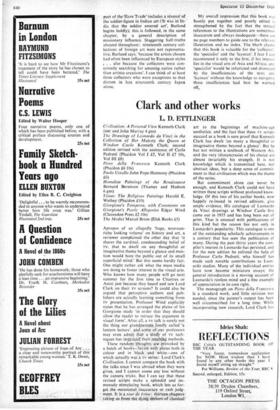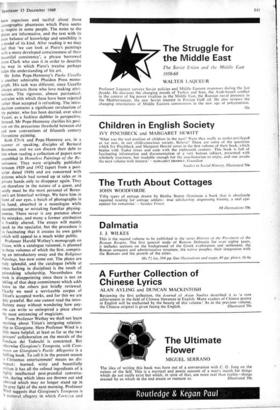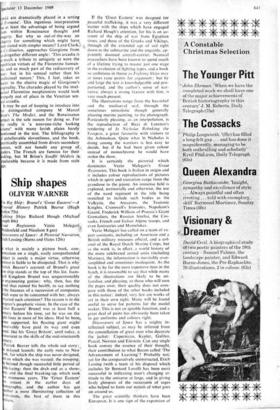Clark and other works
L. D. ETTLINGER
Civilisation: A Personal View Kenneth Clark (sac and. John Murray 4 gns) The Drawings of Leonardo da Vinci in the Collection of Her 'Majesty the_ Queen at Windsor Castle Kenneth Clark; second edition revised with the assistance of Carlo Pedretti (Phaidon Vol T £5, Vol II £7 10s, Vol III £8) Piero della Francesca Kenneth Clark (Phaidon £6 10s) Paolo Uccello John Pope-Hennessy (Phaidon £6) Homeless Paintings'. of the Renaissance Bernard Berenson (Thames and Hudson 6 gns) Titian: The Religious Paintings Harold E. Wethey (Phaidon £10) Giorgione's Ternpesta, with Comments on Giorgione's Poetic Allegories Edgar Wind (Clarendon Press £2 10s) The Medici Marcel Brion (Elek Books £5) Apropos of an allegedly 'huge, nouveau- riche looking volume' on history and art, a reviewer complained the other day that 'it shares the cardinal, condescending belief of Tv, that to dwell on any thoughtful or imaginative theme beyond a glance and men- tion would bore the public out of its small superficial mind.' But this seems hardly fair. One might rather ask what the mass media are doing to foster interest in the visual arts. Who- knows how many people will go next summer for the first time to Chartres: or Assisi just because they heard and saw Lord Clark on their Tv screens? It could also be argued that _perceptive authors and pub- lishers are actually learning something from Tv presentation. Professor Wind explicitly states that he has arranged the plates of his Giorgione study 'in order that they should allow the reader to retrace the argument in visual form'. After. All, a TV talk is surely not the thing our grandparents fondly called `a lantern lecture'. and some of Our professors may even admit that a Study of Iv tech- niques has impr(i.yed their teaChihg methods.
These random Thoughts are--provoked' by a batch of books—lavish with plates both in colour and in black and white—one of which actually was a Tv Series: Lord Clark's Civilisation. I cannot compare the book with the talks since I was abroad when they were given, and I cannot assess any loss without the camera tricks. But I can say that these revised scripts make a splendid and im- mensely stimulating book, which lets us for- get the occasional inaccuracy or rash judg- ment. It is a tour .de force: thirteen chapters taking us from the dying embers of classioal art to the beginnings of machine-age aesthetics; and the fact that these Tv scripts succeed as a book is sure proof that Kenneth Clark has dwelt 'on many a thoughtful or imaginative theme beyond a glance'. But he has not written a textbook of Western Art, and the very idiosyncrasies of his choice are almost invariably his strength. It is not knowledge which is transmitted here, nor abstract ideas, but a deep sense of commit- ment to that civilisation which was the theme of the series.
But commitment alone can never be enough, and Kenneth Clark could not have written these scripts without profound know- ledge. Of this two of his earlier books, now happily re-issued in revised editions, give ample evidence. His catalogue of Leonardo da Vinci drawings at Windsor Castle first came out in 1935 and has long been out of print. That is unusual with publications of this kind but the reason lies not only in Leonardo's popularity. This catalogue is one of the outstanding scholarly achievements in a century that has seen the publication of many. During the past thirty years the com- piler's interest in Leonardo has persisted, and for the new edition he enlisted the help of Professor Carlo Pedretti, who himself has made such notable contributions to .Leon- ardo studies. Many of the individual. entries have now become miniature essays; the general introduction is a moving account of Leonardo's restless mind and a fine example of appreciation, in its own right, The monograph on Piero della Francesca is a standard work, and. little revision was needed, since the painter's output has been well circumscribed for a long time. While incorporating new research, Lord Clark has
been sagacious and tactful about those iconographic phantasies which Piero seems to inspire in some people. The notes to the plates are informative, and the text with its even balance of knowledge and sensibility is
a model of its kind. After reading it we may
feel that 'we can look at Piero's paintings with a more developed consciousness of their beautiful consistency', a phrase borrowed from Clark who uses it in order to describe the way in which Piero's treatise perhaps helps the understanding of his art.
Mr John Pope-Hennessy's Paolo Uccello is another admirable Phaidon Press mono- graph. His task was different, since Uccello always attracts those who love making attri- butions. The rigorous, almost puritanical, restraint with which these have been rejected rather than accepted is refreshing. The intro- duction contains a significant revaluation of the painter, who has been decried, ever since Vasari, as a feckless dabbler in perspective. Instead, Mr Pope-Hennessy clarifies his posi- tion on the precarious threshold between old and new conventions of fifteenth century Florentine painting.
Both Clnrk and Pope-Hennessy are, in a manner of speaking, disciples of Bernard Berenson, and we can discern their debt to him when reading a collection of papers now assembled in Homeless Paintings of the Re- naissance. They were originally published between 1929 and 1932 (apart from a post- script dated 1949) and are concerned with pictures which had turned up at sales or in private hands only to disappear again. They are therefore in the nature of a quest, and surely must be the most personal of Beren- son's art historical writings. We have him in front of our eyes, a batch of photographs in his hand, absorbed in a monologue while encountering or mistaking familiar physiog- nomies. There never is any pretence about the mistakes, and many a former attribution is frankly altered. The essays will mainly speak to the -specialist, but the procedure is so fascinating that it creates its own genie which will appeal to a much wider public.
Professor Harold Wethey's monograph on Titian, with a catalogue raisonne, is planned in three volumes of which the first, compris- mg an introductory essay and the Religious Paintings, has now come out. The plates are truly splendid, and the catalogue (while at times lacking in discipline) is the result of painstaking scholarship. Nevertheless the book is disappointing since there is not an inkling of that deep commitment which adds lustre to the others just briefly reviewed. Clearly we need a serviceable corpus of Titian's accepted works, and for this we are duly grateful. But one cannot read the intro- ductory essay without wondering how any- one can write so uninspired a piece about the most entrancing of magicians.
From Professor Wethey we shall not learn anything about Titian's intriguing relation- ship to Giorgione. Here Professor Wind is a little more helpful, at least as far as the two Painters' collaboration on the murals of the Fondaco dei Tedeschi is concerned. But otherwise Giorgione's Ternpesta, with Com- ments on Giorgione's Poetic Allegories is a baffling book. To call it in the present season a Christmas entertainment' means no dis- respect: learned, witty and beautifully written it has all the refined ingredients of a highly intellectual post-prandial conversa- ton, during which ideas are thrown out and admired which may no longer stand up in the grey light of the next morning. Professor Wind suggests that Giorgione's Tetnpesta is a pastoral allegory in which Fortezza and arita are dramatically placed in a setting ,f Fortuna'. This ingenious interpretation has at least the advantage of being argued from within Renaissance thought and Imagery. But why so out-of-the-way an 111egory for something which might have teen stated with simpler means? Lord Clark, 4 4. Civilisation, approaches Giorgione from altogether different angle: 'This arcadia is much a tribute to antiquity as were the piablican vistas of the Florentine human- Ls, and as much part of the rediscovery of an: but in his sensual rather than his tellectual nature.' This, I feel, takes us arer to the elusive magic of Giorgione's 10314. The charades played by the intel- tual Florentine neoplatonists would look rangely out of place in the Venetian sen- al arcadia.
It may be out of keeping to intoduce into 's distinguished company M Marcel non's The Medici, and the Renaissance bject is the sole reason for doing so. For is really is 'a nouveau-riche looking olume' with many lavish plates barely entioned in the text. The bibliography is f unbelievable slovenliness, and the book, ncritically assembled from divers secondary urces, will not benefit any group ofk, eaders. The French are famous for their ooking, but M Brion's Soufflé Medicis npalatable because it is made from stale
















































 Previous page
Previous page